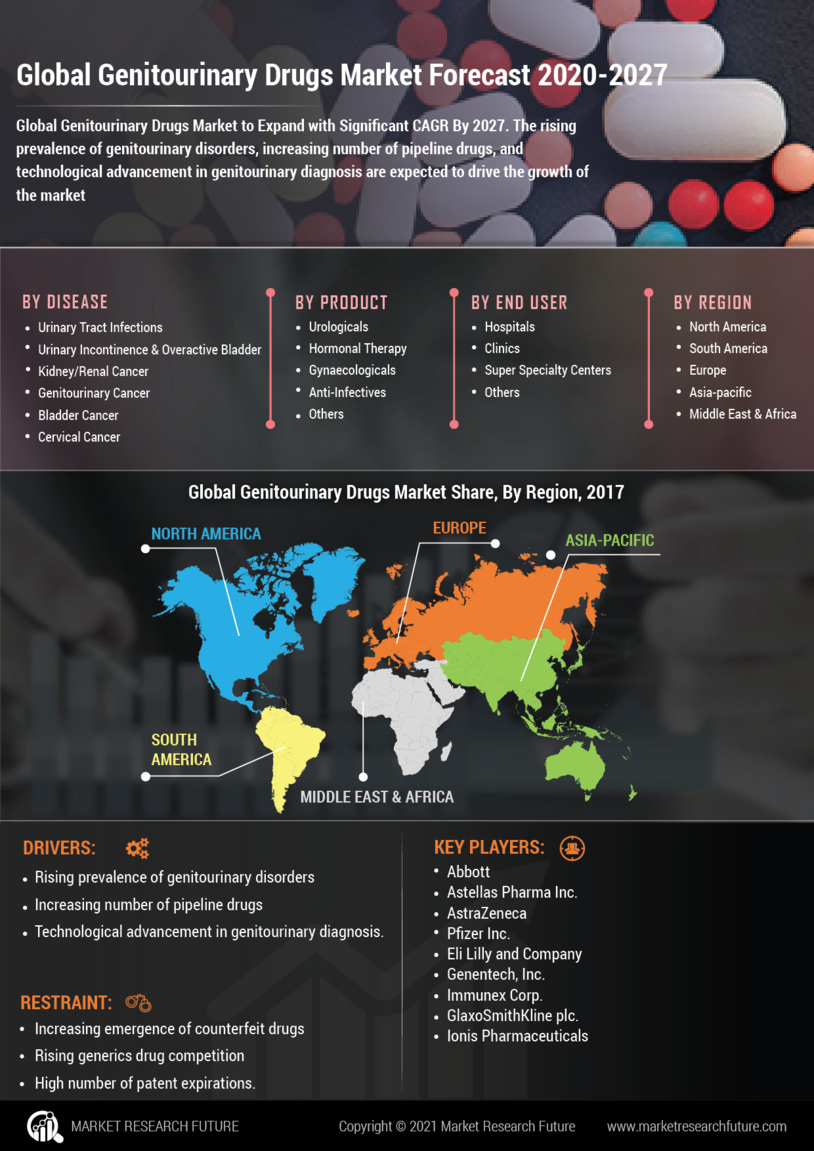Genitourinary Drugs Market Overview:
The genitourinary medicines market is estimated to be worth USD 72.9 billion by the end of the forecast period, with a CAGR of 3.6% (2023-2032). Damage to the urinal or genital parts of the human body causes genitourinary diseases. The genitourinary system includes the kidney, bladder, ureter, and urethra, and genitourinary medications are used to address medical issues caused by these organs. The rising prevalence of genitourinary illnesses, increased pipeline drug development, and technological innovation in genitourinary diagnostics are projected to fuel market expansion.
According to the National Library of Medicine in the United States, more than 480 clinical studies are planned for the treatment of urinary tract infections. Center for Health Information, Furthermore, increased R&D investment and collaborative methods used by the industry's leading competitors, such as licensing and partnerships, are driving market expansion.
Segmentation
The genitourinary drugs market has been segmented on the basis of disease, product, and end-user.
On the basis of disease, the market has been classified urinary tract infections, erectile dysfunction, urinary incontinence & overactive bladder, kidney/renal cancer, genitourinary cancer, bladder cancer, bladder cancer, cervical cancer, sexually transmitted diseases, interstitial cystitis, hematuria, ovarian cancer, prostate cancer, and others.
The product segment has been divided into urologicals, hormonal therapy, gynecologicals, and anti-infectives.
The market, by end-user, has been segmented into hospitals, clinics, super specialty centers, and others.
The market has been segmented, by region, into the Americas, Europe, Asia-Pacific, and the Middle East & Africa. The genitourinary drugs market in the Americas has further been segmented into North America and South America, with the North American market divided into the US and Canada.
The European genitourinary drugs market has been segmented into Western Europe and Eastern Europe. Western Europe has further been classified as Germany, France, the UK, Italy, Spain, and the rest of Western Europe.
The genitourinary drugs market in Asia-Pacific has been segmented into Japan, China, India, South Korea, Australia, and the rest of Asia-Pacific. The genitourinary drugs market in the Middle East & Africa has been segmented into the Middle East and Africa.
Regional Market Summary
The Americas are likely to dominate the genitourinary drugs market owing to the rising prevalence of genitourinary disorders in aging population, increase in the healthcare expenditure, and the presence of a well-established healthcare system. According to the National Kidney Foundation, Urinary tract infections (UTIs) are responsible for nearly 10 million doctor visits each year and approximately 20% women suffer from UTI at least once in a life.
The European market is expected to be the second-largest genitourinary drugs market. The market growth in this region can be attributed to the increasing research and development, rise in number of chronic diseases such as diabetes, and government initiatives for the development of healthcare sector. According to the International Diabetes Foundation, diabetes is major health concern in European region and in 2017, approximately 9.1% of total European population was suffering from diabetes.
Asia-Pacific is expected to be the fastest-growing genitourinary drugs market during the forecast period owing to the increasing geriatric production along with rise in number of genitourinary disorders, rising investments in healthcare and expansions by market players in the region. According to United Nations, Department of Economic and Social Affairs, in 2016, 12.4% of total population in Asian countries was 60 year or older.
The market in the Middle East & Africa is expected to hold the smallest share of the genitourinary drugs market due to lack of technical knowledge, undeveloped healthcare sector, and poor medical facilities.
Genitourinary Drugs Disease Outlook
- Urinary Tract Infections
- Urinary Incontinence & Overactive Bladder
- Kidney/Renal Cancer
- Genitourinary Cancer
- Bladder Cancer
- Cervical Cancer
- Sexually Transmitted Diseases
- Interstitial Cystitis
- Hematuria
- Ovarian Cancer
- Prostate Cancer
- Others
Genitourinary Drugs Product Outlook
- Urologicals
- Hormonal Therapy
- Gynaecologicals
- Anti-Infectives
- Others
Genitourinary Drugs End-User Outlook
- Hospitals
- Clinics
- Super Specialty Centers
- Others
Genitourinary Drugs Region Outlook
- Americas
- North America
- South America
- Europe
- Western Europe
- Germany
- France
- Italy
- Spain
- UK
- Rest of Western Europe
- Eastern Europe
- Asia-Pacific
- Japan
- China
- India
- Australia
- South Korea
- Rest of Asia-Pacific
- The Middle East & Africa
Company Profiles
- Abbott
- Astellas Pharma Inc.
- AstraZeneca
- Pfizer Inc.
- Eli Lilly and Company
- Genentech, Inc.
- Immunex Corp.
- GlaxoSmithKline plc.
- Ionis Pharmaceuticals
- Merck & Co., Inc.
- Novartis AG
- Bristol-Myers Squibb Company
- Antares Pharma
- Bayer AG
Recent Development
November 2023Pfizer announces positive results from a Phase 3 clinical trial of its investigational drug, PF-06939999, for the treatment of overactive bladder (OAB). The trial showed that PF-06939999 was significantly more effective than placebo in reducing the number of urge urinary incontinence (UUI) episodes and the number of times patients urinate per day.AstraZeneca announces that it has received FDA approval for its drug, Lynparza® (olaparib), for the treatment of patients with metastatic castration-resistant prostate cancer (mCRPC) who have a BRCA1 or BRCA2 mutation. Lynparza® is the first PARP inhibitor to be approved for the treatment of mCRPC with a BRCA1 or BRCA2 mutation.Merck & Co., Inc. announces that it has submitted a New Drug Application (NDA) to the FDA for its investigational drug, KEYTRUDA® (pembrolizumab), for the treatment of patients with locally advanced or unresectable urothelial carcinoma (UC) who have progressed on or following platinum-based chemotherapy. KEYTRUDA® is an immunotherapy drug that targets PD-1, a protein that helps cancer cells evade the immune system.October 2023Bristol Myers Squibb Company announces that it has received FDA approval for its drug, Opdivo® (nivolumab), in combination with Yervoy® (ipilimumab), for the treatment of patients with advanced or metastatic renal cell carcinoma (RCC) who have progressed on or following anti-angiogenic therapy. Opdivo® and Yervoy® are immunotherapy drugs that target PD-1 and CTLA-4, respectively.GSK announces that it has received FDA approval for its drug, ViiV Healthcare's Cabenuva®, for the first-time treatment of HIV-1 infection in adults who are virologically suppressed on a stable antiretroviral regimen. Cabenuva® is a long-acting injectable combination of cabotegravir and rilpivirine that is administered once every two months.September 2023Johnson & Johnson announces that it has submitted an NDA to the FDA for its investigational drug, Erleada® (apalutamide), for the treatment of patients with non-metastatic castration-resistant prostate cancer (nmCRPC). Erleada® is a nonsteroidal androgen receptor antagonist (AR) inhibitor that is designed to block the growth of prostate cancer cells.Sanofi announces that it has received FDA approval for its drug, Dupixent® (dupilumab), for the treatment of moderate-to-severe atopic dermatitis in adolescent and adult patients who are candidates for systemic therapy. Dupixent® is a biologic drug that targets the IL-4 and IL-13 signaling pathways, which play a role in the inflammation associated with atopic dermatitis.
Intended Audience
- Pharmaceutical Industry
- Healthcare providers
- Medical device manufacturers
- Research institutes and academic centers
- Contract research organizations (CROs)
- Government associations
- Market research and consulting
|
Report Attribute/Metric
|
Details
|
|
Market Size
|
USD 72.9 billion
|
|
CAGR
|
3.6%
|
|
Base Year
|
2019
|
|
Forecast Period
|
2023-2032
|
|
Historical Data
|
2018
|
|
Forecast Units
|
Value (USD Million)
|
|
Report Coverage
|
Revenue Forecast, Competitive Landscape, Growth Factors, and Trends
|
|
Segments Covered
|
Disease, Product, and End-user
|
|
Geographies Covered
|
North America, Europe, Asia-Pacific, and Rest of the World (RoW)
|
|
Key Vendors
|
Abbott, Astellas Pharma Inc., AstraZeneca, Pfizer Inc., Eli Lilly and Company, Genentech Inc., Immunex Corp., GlaxoSmithKline plc., Ionis Pharmaceuticals, Merck & Co. Inc., Novartis AG, Bristol-Myers Squibb Company, Antares Pharma, Bayer AG
|
|
Key Market Opportunities
|
New product launches and R&D Amongst major key Players
|
|
Key Market Drivers
|
· Rising prevalence of genitourinary disorders
· Increasing number of pipeline drugs
· Technological advancement in genitourinary diagnosis
|
Genitourinary Drugs Market Highlights:
Frequently Asked Questions (FAQ) :
The genitourinary drugs market is projected to grow at a 3.6% CAGR between 2023-2032.
The genitourinary drugs market is predicted to touch USD 72.9 billion by 2032
The Americas is projected to command the largest share in the genitourinary drugs market.
Rising prevalence of cancer and increasing number of drugs in pipeline are adding market growth.
Drug patent expirations may limit market growth.



























